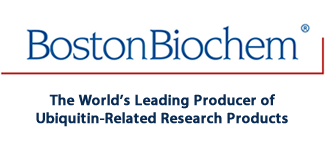
Recombinant Human Poly-SUMO3 Wild-type Chains (2-8), CF Summary
Product Datasheets
Carrier Free
CF stands for Carrier Free (CF). We typically add Bovine Serum Albumin (BSA) as a carrier protein to our recombinant proteins.Adding a carrier protein enhances protein stability, increases shelf-life, and allows the recombinant protein to be stored at a more dilute concentration.The carrier free version does not contain BSA.
In general, we advise purchasing the recombinant protein with BSA for use in cell or tissue culture, or as an ELISA standard.In contrast, the carrier free protein is recommended for applications, in which the presence of BSA could interfere.
ULC-310
| Formulation | X mg/ml in 50 mM HEPES pH 8, 100 mM NaCl, 1 mM DTT |
| Shipping | The product is shipped with dry ice or equivalent. Upon receipt, store it immediately at the temperature recommended below. |
| Stability & Storage: | Use a manual defrost freezer and avoid repeated freeze-thaw cycles.
|
Reconstitution Calculator
Background: Poly-SUMO3
Human Small Ubiquitin-like Modifier 3 (SUMO3), also known as SMT3A, is synthesized as a 103 amino acid (aa), propeptide with a predicted 11.5 kDa. SUMO3 contains a two aa C-terminal prosegment. Poly-SUMO3 represents chains of wild-type recombinant human SUMO3 molecules linked via lysine residue 11, which is the point of attachment for the C-terminal glycine residue of the preceding SUMO3 (1). SUMO3 monomers and dimers have been removed from the chain mixture. Human SUMO3 shares 83% sequence identity with mouse SUMO3. Di-SUMO3 can be used as a substrate for SUMO-specific isopeptidases (SENPs) and DeSUMOylating Isopeptidase 1 (DeSI-1) that cleave the isopeptide linkage between two SUMO3 molecules (2). It can also be used to investigate mechanisms of binding and recognition by SUMO-activating (E1) enzymes, SUMO-conjugating (E2) enzymes, SUMO ligases (E3s), and other proteins that contain SUMO binding domains.
SUMOs are a family of small, related proteins that can be enzymatically attached to a target protein by a post-translational modification process termed SUMOylation (3-5). Unlike SUMO1 which is usually conjugated to proteins as a monomer, SUMO2 and SUMO3 form high molecular weight polymers on proteins. All SUMO proteins share a conserved Ubiquitin domain and a C-terminal diglycine cleavage/attachment site. Following prosegment cleavage, the C-terminal glycine residue of SUMO3 is enzymatically attached to a lysine residue on a target protein. In humans, SUMO3 is conjugated to a variety of molecules in the presence of the SAE1/UBA2 SUMO-activating (E1) enzyme and the UBE2I/Ubc9 SUMO-conjugating (E2) enzyme (6,7). In yeast, the SUMO-activating (E1) enzyme is Aos1/Uba2p (8).
Poly-SUMO-3 chains can be used to investigate mechanisms of chain recognition, binding and hydrolysis by SUMO-specific isopeptidases (SENPs), SUMO-specific E3 ligases or other proteins that contain SUMO-3 binding domains. This product is formed enzymatically with wild type Human Recombinant SUMO-3 linked via lysine 11 which is the point of attachment for the C-terminal glycine of the preceding SUMO-3. Mono-SUMO-3 has been removed from the chain mixture.
- Bylebyl, G.R. et al. (2003) J. Biol. Chem. 278:44113.
- Shin, E.J. et al. (2012) EMBO Rep. 13:339.
- Desterro, J.M. et al. (1997) FEBs. Lett. 417:297.
- Bettermann, K. et al. (2012) Cancer Lett. 316:113.
- Praefcke, G.J. et al. (2012) Trends Biochem. Sci. 37:23.
- Okuma, T. et al. (1999) Biochem. Biophys. Res. Commun. 254:693.
- Tatham, M.H. et al. (2001) J. Biol. Chem. 276:35368.
- Johnson, E.S. et al. (1997) EMBO J. 16:5509.
Citation for Recombinant Human Poly-SUMO3 Wild-type Chains (2-8), CF
R&D Systems personnel manually curate a database that contains references using R&D Systems products.The data collected includes not only links to publications in PubMed,but also provides information about sample types, species, and experimental conditions.
1Citation: Showing 1 - 1
- The adenovirus E4-ORF3 protein functions as a SUMO E3 ligase for TIF-1? sumoylation and poly-SUMO chain elongationProc Natl Acad Sci USA, 2016;113(24):6725-30.Species: HumanSample Types: Recombinant ProteinApplications: Bioassay
FAQs
No product specific FAQs exist for this product, however you may
View all Proteins and Enzyme FAQsAffinity Matrices
Recombinant Human HR23A Tandem UBA (TUBE1) Agarose, CF
Recombinant Enzymes
Recombinant Human SUMO E1 (SAE1/UBA2) Protein, CF
Recombinant Human UBE2I/Ubc9 Protein, CF
Recombinant Proteins
Recombinant Human SUMO2 Protein, CF
Recombinant Human SUMO1 AMC Protein, CF
Recombinant Human Ubiquitin Protein, CF
Reviews for Recombinant Human Poly-SUMO3 Wild-type Chains (2-8), CF
There are currently no reviews for this product. Be the first toreview Recombinant Human Poly-SUMO3 Wild-type Chains (2-8), CF and earn rewards!
Have you used Recombinant Human Poly-SUMO3 Wild-type Chains (2-8), CF?
Submit a review and receive an Amazon gift card.
$25/€18/£15/$25CAN/¥75 Yuan/¥1250 Yen for a review with an image
$10/€7/£6/$10 CAD/¥70 Yuan/¥1110 Yen for a review without an image
ebiomall.com






>
>
>
>
>
>
>
>
>
>
>
>
各位业内前辈,我们正在考虑引进符合GMP认证标准的CHO细胞系,用于表达可做疫苗生产的重组蛋白类。目前已有符合标准信息的是Thermofisher的CHO-S悬浮培养细胞资料,希望能再多了解一些和这株细胞类似的其他公司符合GMP标准的生产株细胞做个比较。谢谢指教!
大家好,想请教大家一个关于HPLC方法学的问题。
目前我们做的一个蛋白药,没有标准品,液相建立一个方法只想用于纯度鉴定,不去定量,这个方法所得到的图谱就一个主蛋白峰,面积归一化法相当于100%,现在就这个方法的方法学验证提出下面几点疑问:
1.因为我只做纯度鉴定,这个方法的方法学应该做系统适用性、专属性、检测限、耐用性和精密度这些,还是按照定量的全套加上定量限、线性、范围、准确度这些?
2.纯度鉴定中,我觉得应该对杂质进行定量,但是我们的这个方法只有一个主蛋白峰,几乎没有杂质峰,这样的话这个方法学我应该以什么为标准证明纯度呢?需将样品进行适当的氧化、酸、碱破坏吗?然后证明破坏后主峰能和产生的杂质分开?
3.对应生物蛋白药的杂质,应该属于无法获得的,如果通过强破坏,这个杂质也是不好鉴定的,是不是我只需要知道主峰能和强破坏的降解物分开,就可以说方法建立成功?还是生物药没有必要做这个强破坏,简单的走一下系统适用性、专属性、检测限、耐用性和精密度这样的流程就行?
说的有点乱,主要是自己对这个生物药的HPLC纯度鉴定的方法学,实在是疑惑重重,希望有经验的大侠能帮忙解答下。非常感谢!
E.coliExpressionSystems.pdf(136.05k)
2.准备旋转培养瓶,用于按比例扩增Sf9细胞,将合适大小的两孔盖连接在转瓶的一个 侧臂,另用一平盖接在另一侧臂。将一段短管(约6英寸或15 cm)装在通气孔中,末端连接一滤器,借助张力器用管索将管子与通气孔和滤器固牢。
3.将一段长管(30~60 cm)连接至进气孔,并在末端连接一滤器,用管索加固,另一段管子连接于滤器的另一端,用管索固牢。管子末端用铝箔封好。
4.将与两孔装置相对的侧壁上的盖子旋转90度以松开,高压灭菌培养瓶1 h。
5.将适应了无血清培养液的细胞接种于经高压灭菌的培养瓶中。将培养瓶装至半
1.测定——分子量、PI
当目标蛋白的物理特性如分子量、PI等都不清楚时,可用PAGE电泳方法或层析方法加以测定。分离范围广阔的Superose HR预装柱很适合测定未知蛋白的分子量。用少量离子交换介质在多个含不同PH缓冲液的试管中,可简易地测出PI,并选择纯化用缓冲液的最佳PH。
2.选择——层析方法
若对目标蛋白的特性或样品成分不太了解,可尝试几种不同的纯化方法:
一 使用最通用的凝胶过滤方法,选择分离范围广阔的介质如Superose、Sephacryl HR依据分子量将样品分成不同组份。
二 用含专一配体或抗体的亲和层析介质结合目标蛋白。亦可用各种活化偶联介质偶联目标蛋白的底物、受体等自制亲和介质,再用以结合目标蛋白。一步即可得到高纯度样品。
三 体积大的样品,往往使用离子交换层析加以浓缩及粗纯化。高盐洗脱的样品,可再用疏水层析纯化。疏水层析利用高盐吸附、低盐洗脱的原理,洗脱样品又可直接上离子交换等吸附性层析。两种方法常被交替使用于纯化流程中。
3.纯化——大量粗品
处理大量原液时,为避免堵塞柱子,一般使用sepharose big beads、sepharoseXL、sepharose fast flow等大颗粒离子交换介质。扩张柱床吸附技术利用多种STREAMLINE介质,直接从含破碎细胞或组织萃取物的发酵液中俘获蛋白。将离心、超滤、初纯化结合为一。提高回收率,缩短纯化周期。
4.纯化——硫酸氨样品
硫酸氨沉淀方法常被用来初步净化样品,经处理过的样本处于高盐状态下,很适合直接上疏水层析。若作离子交换,需先用Sephadex G-25脱盐。疏水层析是较新技术,随着介质种类不断增多,渐被融入各生产工艺中。利用Hitrap HIC Test Kit 和RESOURCE HIC Test Kit可在八种疏水介质中选择最适合介质及最佳的纯化条件。低盐洗脱的样品可稍加稀释或直接上其它吸附性层析。
5.纯化——糖类分子
固化外源凝订素如刀豆球蛋白、花生、大麦等凝集素,可结合碳水化合物的糖类残基,很适合用作分离糖化细胞膜组份、细胞、甚至亚细胞细胞器,纯化糖蛋白等。两种附上外源凝集素的Sepharose 6MB亲和层析介质,专为俘获整个细胞或大复合物,如膜囊等。
6.纯化——膜蛋白
膜蛋白分离常使用去污剂以保持其活性。离子性去污剂应选用与目标蛋白相反电荷者,避免在作离子交换时和目标蛋白竞争交换介质,藉此除去去污剂。非离子性去污剂可以疏水层析除去。
7.纯化——单抗、抗原
单抗多为IgG.来源主要是腹水和融合瘤培养上清液。在培养前除去IgG.重组蛋白A介质Mabselect和rProtein A Sepharose FF对IgG有更高的载量和专一性,基团脱落更少。脱落的rProtein A用离子交换Q Sepharose HP或凝胶过滤Superdex 200,很容易去除。
疏水层析Phenyl Sepharose HP亦很适合纯化IgG.宿主抗体和污染IgG可用凝胶过滤Superdex 200在精细纯化中去除。
纯化IgG抗原最有效的方法是用活化偶联介质如CNBr、NHs activated Sepharose FF偶联IgG,再进一步获取IgG抗原。
HiTrap IgM是用来纯化融合瘤细胞培养的单抗IgM,结合量达5mg IgM.HiTrap IgY是专门用来纯化IgY,结合量达100mg纯IgY.
8.纯化——重组蛋白
重组蛋白在设计、构建时应已融入纯化构想。样品多夹杂了破碎细胞或溶解产物,扩张柱床吸附技术STREAMLINE便很适合做粗分离。Amersham biosciences提供三个快速表达、一步纯化的融合系统。
一 GST融合载体使要表达的蛋白和谷胱甘肽S转移酶一起表达,然后利用Glutathione Sepharose 4B作亲和层析纯化,再利用凝血酶或因子Xa切开。
2. 蛋白A融合载体使要表达的蛋白和蛋白A的IgG结合部位融合在一起表达,以IgG Sepharose 6 FF纯化。
二 含组氨酸标记(Histidine-tagged)的融合蛋白可用Chelating Sepharose FF螯合Ni2+金属,在一般或变性条件(8M尿素)下透过组氨酸螯合融合蛋白。HisTrap试剂盒提供整套His-Tag蛋白的纯化方法。
9.纯化——包涵体蛋白
包涵体蛋白往往需溶于6M盐酸胍或8M尿素中。一般包涵体蛋白样品的纯度越高,复性效果越好。SOURCE 30 RPC反相层析介质很适合纯化复性前的粗品,并可以1MnaOH重生。此方法纯化后的包涵体蛋白,复性回收率明显提高。
10.包涵体蛋白固相复性
许多文献报导将包涵体蛋白在变性条件下固定(吸附)在层析介质上,一般用各种Sepharose FF离子交换层析介质。而且无需大量稀释样品,并将复性和初纯化合二为一,大大节省时间及提高回收率。
固相复性方法也被用于以HiTrap Chelating金属螯合层析直接复性及纯化包涵体形式表达的组氨酸融合蛋白;以HiTrap Heparin肝素亲和层析直接复性及纯化包涵体形式表达的含多个赖氨酸的融合蛋白。两种亲和层析预装柱均可反复多次重复使用,比一般试剂盒更方便、耐用。
11.纯化——中草药有效成分
中药的化学成分极其复杂。例:如用甲醇分离黄酮甙,三糖甙先被洗下来,二糖甙其次,单糖甙随后,最后是甙元。Sephadex LH-20可使用水、醇、丙酮、氯仿等各种试剂,广泛用于各种天然产物的分离,包括生物碱、甙、黄酮、醌类、内脂、萜类、甾类等。
生物碱在酸性缓冲液中带正电,成为盐,HiTrap SP阳离子交换层析柱可以分离许多结构非常近似的生物碱。相反,黄酮、蒽醌、皂甙、有机酸等可溶于偏碱的缓冲液中,在HiTrap Q阴离子交换柱上分离效果良好。
一般多糖纯化大多使用分子筛如Sephadex,Sephacryl.若分子量在600KD以下,并需更高分辨率,可选择新一代的Superdex.一般植物可能含水溶性、酸溶性、碱溶性多种多糖。SOURCE5、15、30RPC反相层析也很适合各种中药有效成分的检测、分离和放大制备。由于中药的成分非常复杂,SOURCE反相层析可用范围为PH1-14 ,并可用1M NaOH,1M HCL清洗、再生。比传统硅胶反相层析更易于工艺优化及在位清洗,寿命也更长。
12.纯化——肽类
肽类的来源有天然萃取,合成肽和重组肽三种。肽容易被酶降解,但可从有机溶剂或促溶剂中复性,所以多以高选择性的反相层析如SOURCE 30RPC、SOURCE 15RPC、SOURCE 5RPC或离子交换Minibeads、Monobeads作纯化。Superdex Peptide HR是专为肽分子纯化设计的凝胶过滤预装柱,能配合反相层析做出更精美的肽图。肽分子制备可用离子交换配合凝胶过滤Superdex 30 PG。医学都市多功能
13.纯化——核酸、病毒
核酸的纯化用于去除影响测序或PCR污染物等研究。核酸可大致上分为质粒DNA、噬菌体DNA和PCR产物等。病毒也可视作核酸大分子,和质粒DNA一样,可用分离大分子的Sephacry S-1000 SF、Superose或Sepharoce 4FF凝胶过滤介质去除杂蛋白,再配合离子交换如Mono Q、 SOURCE Q分离核酸。
14.纯化——寡核苷酸寡酸苷酸
多应用在反义(anti-sense)DNA、RNA测序、PCR和cDNA合成等研究。合成后含三苯甲基的寡核苷酸以阴离子交换的Mono Q或快速低反压的SOURCE Q在PH12下可除副产物,并避免凝集和保护基的脱落。载量大大高过反相层析,可用做大量制备。不含三苯甲基的失败序列可用反相柱ProRPC去除。
15.脱盐、小分子去除
使用凝胶过滤介质Sephadex G10,G15,G25,G50等去除小分子,效率高,处理量可达床体积30%.只需在进样后收集首1/3-1/2柱体积的洗脱液,HiPrep Desalting(26ml)可在数分钟为多至10ml样品脱盐。
16.疫苗纯化
使用凝胶过滤介质Sepharose 4FF纯化疫苗,去除培养基中的杂蛋白,处理量可大于床体积10%.柱高一般40-70cm,整个过程约半至一小时。使用此法生产的疫苗品种有乙肝、狂犬、出血热、流感、肺结核、小儿麻痹疫苗等。分子量较小的疫苗可使用Sephacryl S-500HR,如甲肝疫苗等。
17.抗生素聚合物分析
中国药典从2000年版起要求抗生素头孢曲松钠需要找出聚合物占产品的白分比,规定使用Sephadex G10凝胶过滤法测定。
18.纯化-基因治疗用病毒载体
SORRCE 15Q
19.纯化-基因治疗用质粒
Q Sepharose XL,SOURCE 15Q,STREAMLINE Q,Sephacryl S500,Plasmidselect 在下游纯化中,可应用不同层析技术在纯化生物分子的同时,去除各种污染物。 1.去除——内毒素
内毒素又称热原。含脂肪A、糖类和蛋白,是带负电的复合大分子。
内毒素的脂肪A部份有很强的疏水性。但在高盐下会凝集,无法上疏水层析。利用疏水层析试验盒(17-1349-01)可选择结合目标蛋白的介质而去除内毒素。
内毒素与阴离子交换介质Q或DEAE Sepharose Fast Flow有较强结合。可在洗脱目标蛋白后用高盐缓冲液或NaOH去除。
利用CNBr或NHS Sepharose FF可偶联内毒素底物如LAL,PMB,自动成亲合层析介质结合内毒素。内毒素经常是多聚体,凝胶过滤层析可有效地将之去除。
2.去除——蛋白中的核酸
大量核酸增加样本黏度,令区带扩张,反压增加,降低分辨率和流速。药审和食检对核酸含量也有严格限制。
胞内表达蛋白的核酸问题尤其严重。核酸带阴电荷,在初步纯化时利用阳离子交换介质如STREAMLINESP,SP Sepharose Big Beads,SP或CM Sepharose FF,SP SepharoseXL结合目标蛋白,可除去大量核酸。
核酸在高盐下会和蛋白解离,疏水层析介质很适合用来结合目标蛋白,在纯化蛋白的同时去除核酸。
利用核酸酶将核酸切成小片断,用凝胶过滤做精细纯化时便很容易去除了。
3.去除——病毒和微生物
病毒和微生物可成为病原,应尽量减除。结合不同层析技术,使用注射用水,用NaOH定期进行仪器和凝胶的在位消毒和在位清洗,皆可避免污染物增加。
病毒大都有脂外壳。可用与目标蛋白电荷相反的S/D(solvent/detergent)处理,使病毒失活,如Triton和Tween.再用适当的离子交换介质如CM Sepharose FF结合目标蛋白,去除S/D.
其它污染物可以改变pH和离子强度使其从目标分子中解离或失活,凝胶过滤介质Superdex及多种吸附性介质,SOURCE都是很好的精细纯化介质,可去除多种微量污染物。 凝胶是指颗粒大小在1埃到10埃之间的混合物。高分子溶液和某些溶胶,在适当的条件下,整个体系会转变成一种弹性的半固体状态的稠厚物质,失去流动性。这种现象称为胶凝作用,所形成的产物叫做凝胶或冻胶.
“气凝胶”是指分散系为气态的,如:云,雾等,“固凝胶”有烟水晶等,“液凝胶”就是呈液态的胶体,如氢氧化铁胶体 。向左转|向右转
定量:考马斯亮蓝显色或紫外分光光度计,就是光谱学的方法。
如果是做科研,国内外很多知名的药企都是你学习借鉴的榜样。
我想在体外培养的细胞中,加入PD-L1重组蛋白,激活PD-L1:PD-1通路,但我没能查到相关的文献,不清楚PD-L1重组蛋白的用量。请问各位有相关的经验吗?或者阅读过相关的文献?









